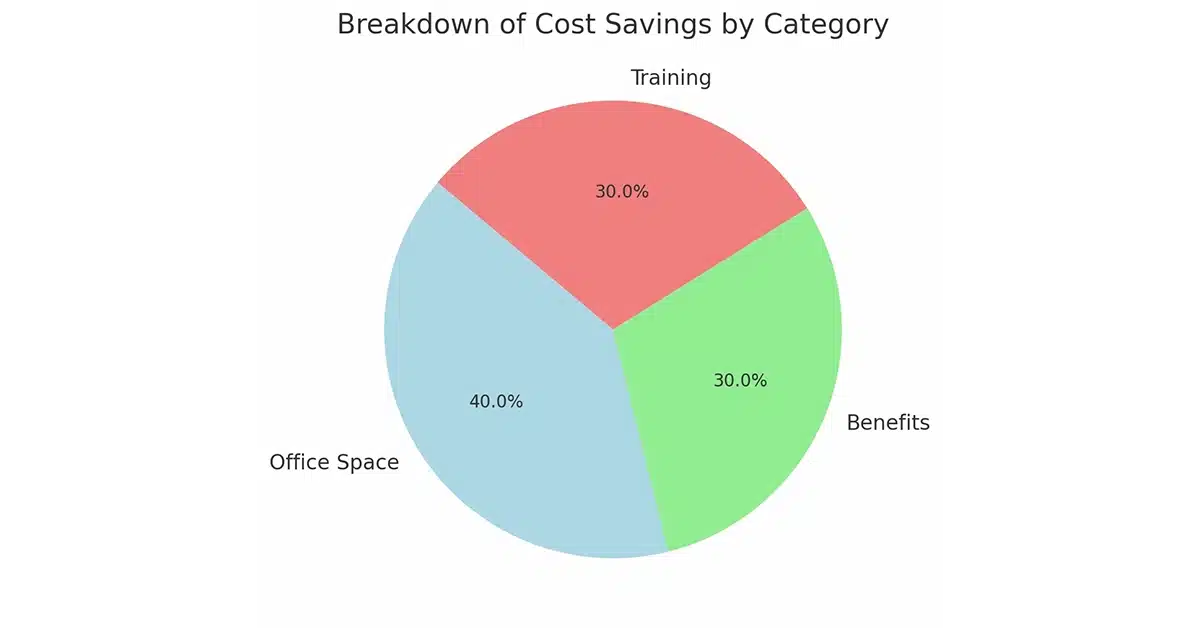Introduction
In an increasingly competitive business environment, companies are seeking innovative ways to reduce operational costs while maintaining productivity and efficiency. Virtual assistants have emerged as an affordable alternative to full-time employees, enabling businesses to allocate resources more strategically. Unlike traditional employees, virtual assistants work remotely and provide specialized services, helping businesses cut unnecessary expenses and simplify business processes.
This article explores how virtual assistants reduce operating costs, focusing on direct financial savings, productivity improvements, and their impact on various business functions.
Direct Cost Savings
Cut Hiring Costs: How Virtual Assistants Save You Money
Hiring a full-time employee involves significant expenses, including salaries, benefits, taxes, and insurance. According to the U.S. Bureau of Labor Statistics, the average employer spends an additional 31% of an employee’s salary on benefits. Virtual assistants, on the other hand, operate as independent contractors, eliminating the need for such expenses.
For businesses that want to compare different VA providers, The Best Virtual Assistant Companies in the US for 2025 offers a detailed review.
Example: A company hiring a full-time administrative assistant at $50,000 annually would incur an additional $15,500 in benefits. By hiring a VA for $30/hour, working 20 hours a week, the company saves over $40,000 annually.
No Office Space or Equipment Costs
VAs work remotely, so businesses don’t need to provide office space, furniture, or equipment. This is especially beneficial for startups and small businesses operating on tight budgets.
Statistics: A study by GlobalWorkplaceAnalytics estimates that businesses save an average of $11,000 annually per remote worker due to reduced office expenses.
Reduced Training Costs
VAs are often highly skilled in specific areas and require minimal training. This contrasts with traditional employees, who may need extensive onboarding and development programs.
Impact: Savings on training can range from a few hundred to thousands of dollars, depending on the role and industry.
Savings on Operational Downtime
With virtual assistants working across different time zones, businesses can maintain operations round-the-clock without incurring overtime pay. This ensures higher productivity and faster turnaround times for critical tasks.
Case Study: A digital marketing agency achieved a 24% increase in task completion rates by employing VAs in various time zones to handle client requests overnight.

Increased Productivity and Efficiency
Specialized Expertise
Virtual assistants are often hired for their expertise in specific areas, such as bookkeeping, marketing, or IT. This specialization ensures that tasks are completed efficiently and accurately, reducing the risk of costly errors.
Example – Small Accounting Firm:
Mark, the owner of a small accounting firm, struggled with managing client invoices and tax reports during the peak season. Hiring a virtual bookkeeper reduced processing errors by 30% and helped Mark meet tight deadlines, avoiding late fees and penalties for his clients.
Example – E-commerce Business: An online store was struggling with delayed invoice processing, leading to cash flow issues. By hiring a VA with experience in financial management, the company reduced invoice processing time by 50%, ensuring faster payments and smoother operations.
Example – Tech Startup: A software company needed someone to manage customer inquiries about product troubleshooting. Instead of hiring a full-time support agent, they brought in a VA with IT knowledge, reducing response times by 40% and improving customer satisfaction scores.
Time Savings for Core Activities
Delegating repetitive tasks to VAs allows business owners and employees to focus on strategic priorities, increasing overall productivity.
Case Study – Small E-Commerce Business: A growing online retailer was overwhelmed with customer inquiries, spending hours daily responding to emails and chats. After hiring a VA for customer support, the core team redirected their time to product development and marketing, leading to a 25% increase in sales within three months.
How Automation & Virtual Assistants Make Your Business Run Smoother
Many VAs integrate automation tools into daily operations, reducing manual workload and minimizing errors. If you need a time-tracking tool to monitor VA performance, check out our Guide to Time Doctor Monitoring & Time Tracking Software.
Example – Retail Business: A retail company that manually tracked inventory faced frequent stock mismanagement. After hiring a VA proficient in inventory management software, they automated tracking and reduced stock discrepancies by 40%, preventing unnecessary losses.
Example – Digital Marketing Agency:
“Emily, the founder of a small marketing agency, spent hours manually scheduling social media posts and tracking engagement. After hiring a VA skilled in automation tools like Buffer and Hootsuite, her team saved 10+ hours per week. This allowed them to focus on content strategy, leading to a 20% increase in client engagement over three months.”
By using VAs with expertise in automation, businesses can optimize workflows, reduce human error, and free up valuable time for strategic tasks.

Flexibility and Scalability
Pay-As-You-Go Model
One of the most significant advantages of hiring virtual assistants is the flexibility to pay only for the hours or tasks required. This contrasts with salaried employees, who must be paid regardless of workload.
Illustration: A company needing 10 hours of data entry work per week can hire a VA at $20/hour, spending just $800 monthly instead of a full-time employee costing over $3,000 monthly.
Seasonal and Project-Based Needs
Businesses with fluctuating workloads benefit from the scalability of virtual assistants. They can quickly increase or reduce support based on demand without the complexities of hiring or laying off staff.
Example: Retailers often hire VAs during the holiday season to handle increased customer inquiries and order processing.
Adaptability to Business Growth
As businesses grow, VAs can take on additional responsibilities or offer specialized services, eliminating the need to hire multiple employees.
Example: A growing startup expanded its operations by hiring VAs skilled in social media marketing and content creation, saving $50,000 annually compared to building an in-house team.

Cost Savings in Specific Business Functions
Administrative Tasks
Virtual administrative assistants handle scheduling, email management, and data entry, reducing the burden on in-house staff.
Savings Estimate: Hiring a VA for administrative tasks can cut costs by up to 50% compared to a full-time assistant.
Bookkeeping and Financial Management
Virtual bookkeeping assistants help businesses manage finances efficiently, from invoicing to tax preparation.For step-by-step guidance, read our article on How to Hire a Virtual Bookkeeping Assistant for Your Business.
Impact: According to a 2023 survey by QuickBooks, businesses that outsource bookkeeping save an average of $15,000 annually.
IT Support
Remote developers and IT support VAs provide technical expertise without the need for in-house IT staff. They handle tasks such as website maintenance, software updates, and troubleshooting.
Case Study: A tech startup saved $25,000 annually by hiring a remote developer to maintain their app instead of employing a full-time developer.
Customer Support
Virtual assistants specializing in customer service can manage inquiries, complaints, and support tickets, ensuring a positive customer experience.
Statistics: Outsourcing customer support to VAs reduces operational costs by 30-50% compared to in-house teams, as per a report by Deloitte.
Marketing and Lead Generation
VAs with expertise in marketing can handle social media management, content creation, and email campaigns, driving leads and increasing brand visibility at a fraction of the cost.
Example: A business saved $20,000 annually by hiring a VA to manage social media accounts instead of a full-time marketing manager.

Technological Integration
Virtual assistants leverage advanced tools and software to automate processes, further reducing costs.
Automation Tools
Virtual Assistants often use tools like Trello, Slack, QuickBooks, and Zapier to optimize workflows, saving time and resources.
Example: A VA managing social media with tools like Buffer or Hootsuite can schedule posts and track analytics, reducing the need for a full-time marketing specialist.
Cloud-Based Solutions
Using cloud-based platforms, VAs can collaborate seamlessly with teams, eliminating the need for expensive IT infrastructure.
Impact: According to a study conducted by Accenture, migrating workloads to the public cloud can reduce the total cost of ownership (TCO) by 30-40%.
Enhanced Data Security
Many irtual Assistants se secure platforms and encrypted tools to ensure data safety, mitigating the risk of costly data breaches.
Example: A finance firm saved $15,000 annually by employing a VA who implemented secure accounting software with built-in encryption.

Measuring the Impact of Virtual Assistants
Businesses should track key performance indicators (KPIs) to evaluate the financial and operational benefits of hiring VAs. Metrics such as cost savings, task completion rates, and ROI help determine the effectiveness of virtual assistants.



Challenges of Working with Virtual Assistants and How to Overcome Them?
While virtual assistants offer many benefits, they can also present certain challenges if not managed properly. Here are some of the most common issues and ways to resolve them.
Different Time Zones
If a VA is working from another country, time zone differences can make coordination and timely communication difficult.
Solution: Using tools like Google Calendar and World Time Buddy helps schedule meetings at convenient times. Additionally, setting clear working hours and maintaining a flexible schedule can minimize availability issues.
Data Security
Sharing confidential information with external collaborators can increase the risk of data breaches or unauthorized access. To avoid scams and ensure data security, read our guide on How to Protect Your Business from Virtual Assistant Scams.
Solution: Using non-disclosure agreements (NDAs), granting limited platform access, and employing encrypted communication channels reduce security risks. Tools like LastPass also allow for secure password sharing without revealing full credentials.
Work Quality and Productivity
Without direct supervision, it can be difficult to ensure that a VA meets expectations in terms of quality and deadlines.
Solution: Providing clear instructions, giving regular feedback, and using task management tools like Trello, Asana, or Time Doctor help monitor performance and efficiency. A trial period of a few weeks can also indicate whether the VA is a good fit for business needs.
Language and Cultural Differences
If a VA is not fluent in the client’s language or is unfamiliar with industry-specific business norms, misunderstandings and errors can occur.
Solution: When selecting a VA, it is important to assess their language proficiency and cultural awareness of the target market. A short test task or trial period can help evaluate adaptability to business requirements.
Limited Access to Internal Systems
VAs often do not have the same level of access to software and databases as full-time employees, which can hinder the completion of certain tasks.
Solution: Using cloud-based solutions with customized permissions and sharing data through secure platforms like Google Drive or Dropbox can facilitate workflow without compromising business information security.

The Future of Virtual Assistants: AI and Automation
Virtual assistants are evolving rapidly with the integration of artificial intelligence (AI). Businesses are now combining AI-powered tools with human virtual assistants to optimize efficiency, automate repetitive tasks, and improve accuracy.
Example – AI-Powered Customer Support: Some companies use AI chatbots alongside human VAs to handle high volumes of customer inquiries, ensuring 24/7 support while still providing a human touch when necessary.
Example – AI in Bookkeeping: AI-driven accounting software allows virtual bookkeeping assistants to automate expense tracking and invoice management, reducing errors and saving hours of manual work.
As AI technology continues to improve, virtual assistants will become even faster at task execution, more affordable for businesses, and capable of handling complex tasks with greater accuracy
Learn how to leverage AI with VAs in our article AI and Virtual Assistants: The Best Way to Use Both in Business.

Conclusion
Virtual assistants are a practical and cost-effective solution for reducing operating expenses. By eliminating the need for office space, benefits, and extensive training, businesses can redirect resources toward growth and innovation. The flexibility and scalability of VAs make them an indispensable asset for companies looking to optimize budgets and remain competitive.
As businesses continue to adapt to remote work and digital solutions, the role of virtual assistants will only grow in importance, offering unparalleled opportunities for cost savings and efficiency improvements. For additional insights and resources about virtual assistants, who are becoming an increasingly important part of business operations, visit our homepage and explore other aspects of this topic in the articles on our blog.



